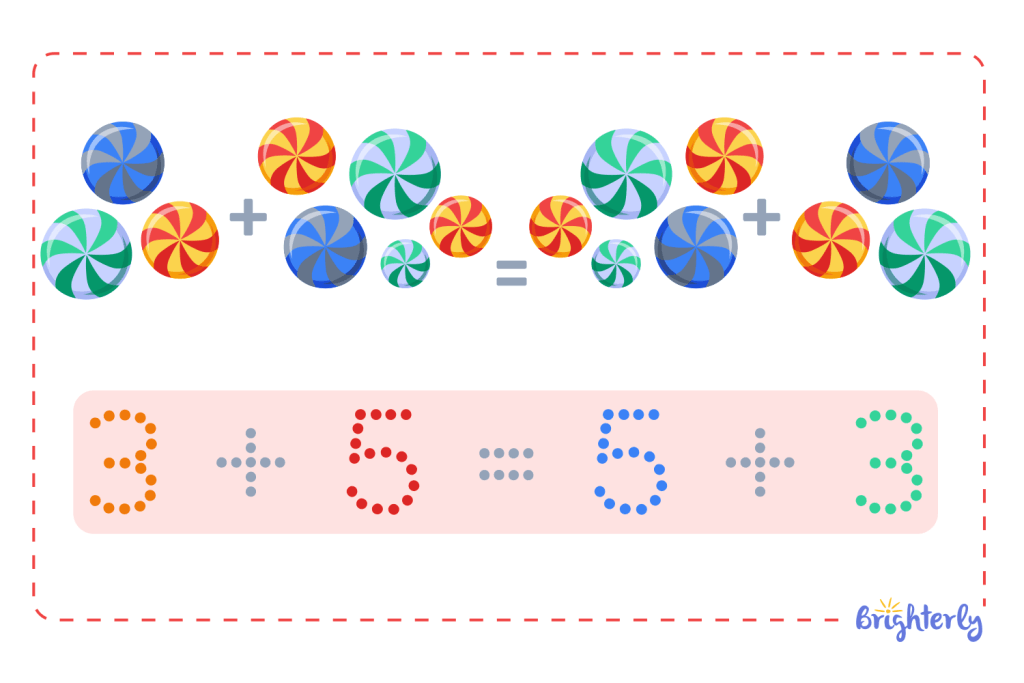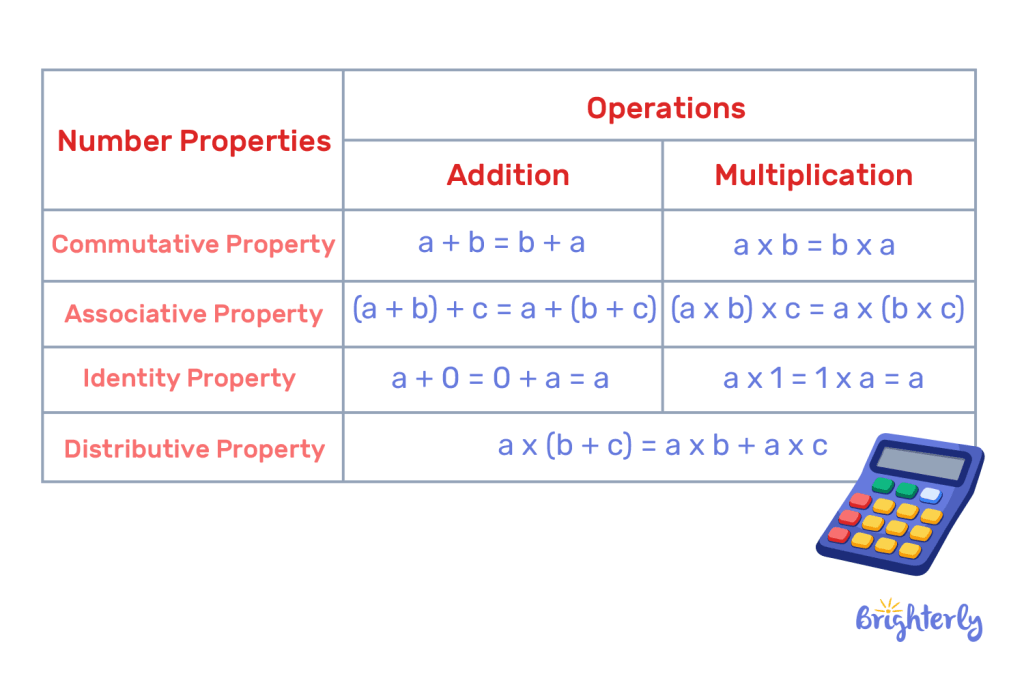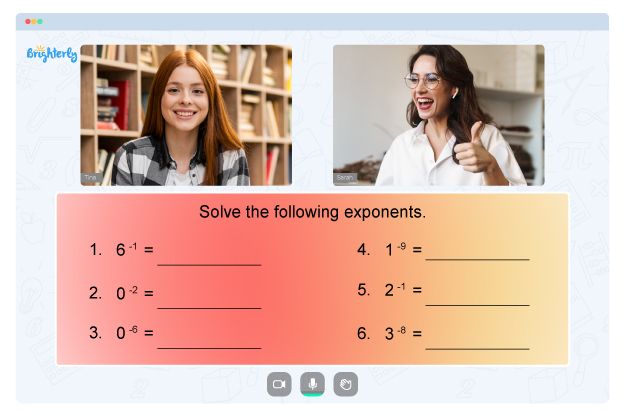Number Properties – Definition, Types, Chart
reviewed by Mary Grace Carlos
Updated on October 30, 2025
Are you ready for another educational journey in math with Brighterly?
Today, we’re going to cover number properties. Numbers have many different properties that help us understand how to work with them and perform operations. Here, we’re going to cover what number properties are and explore key properties like the commutative, associative, distributive, and identity properties. You’ll also see examples of properties for more comprehensive illustration.
About number properties
Number properties, also known as math properties, are attributes of numbers that dictate how we can work with them in math. By understanding number properties, we can see how they behave, which helps us solve various mathematical problems.
What are number properties?
Number properties in math are rules that dictate how numbers work in different mathematical functions, including the basic operations of addition, subtraction, multiplication, and division.
So, what are all the properties in math? They are:
- The commutative property
- The associative property
- The distributive property
- The identity property
Now, we’ll explain all math properties in more detail.
Commutative property
The commutative property can be applied to addition or multiplication. This type teaches that the result will be the same no matter the order of the numbers.
For example, let’s look at adding 2 and 5 together to understand this math property. 2 + 5 = 7, but if we flip the order of the numbers we’re adding, the result is the same – 5 + 2 = 7.
This property applies only to multiplication and addition, but not to subtraction or division.

Associative property
The associative property states that, when three or more numbers are added or multiplied together, the way we group some numbers in the equation does not affect the result.
As an example of this math property, if we want to add 6, 7, and 8 together, we can group the numbers in different ways, and the result will be the same:
- (6 + 7) + 8 = 21
- 6 + (7 + 8) = 21
It works the same in multiplication. Let’s multiply these three numbers:
- (6 x 7) x 8 = 336
- 6 x (7 x 8) = 336
Again, this property does not apply to division or subtraction.
Distributive property
The distributive property shows us that if a number is multiplied by the sum of two numbers, the result will be the same as it would if you multiplied it by those two numbers.
Let’s look at an example of this math property:
- 3 + 4 = 7
- 7 x 5 = 35
- (3 x 5) + (4 x 5) = 35
The distributive property is an essential property that helps you simplify algebraic expressions, too.
Identity property
Under the identity property, we have some specific numbers that, when performed in a specific operation, do not change the value of the number. This is true regardless of the number, and it is the only number property that also applies to subtraction and division.
In addition and subtraction, this math property number is 0, because adding 0 adds nothing, while taking away 0 doesn’t make the number any smaller. For example:
- 9 + 0 = 9
- 9 – 0 = 9
In multiplication and division, this math property number is 1, because multiplying a number by 1 does not increase the number, and dividing it by 1 doesn’t decrease it. For example:
- 8 x 1 = 8
- 8 ÷ 1 = 8
Distributive property of multiplication over addition
The distributive property of multiplication over addition is just another way of describing the distributive property. This way of describing the distributive property tells us how it works – by distributing multiplication over addition. To use another example:
- 2 + 4 = 6
- 6 x 3 = 18
- (2 x 3) + (4 x 3) = 18
Formula chart of basic number properties
Did you know that there are formulas to help you remember and carry out these basic number properties in their relevant operations? Here is a math properties list with formulas so you can master number properties:
Commutative property
The formulas for the commutative property are:
- Addition: a + b = b + a
- Multiplication: a × b = b × a
Associative property
The formulas for the associative property are:
- Addition: (a + b) + c = a + (b + c)
- Multiplication: (a × b) × c = a × (b × c)
Distributive property
The formula for the distributive property, also known as the distributive property of multiplication over addition, is:
a × (b + c) = (a × b) + (a × c)
Identity property
The formulas for the identity property are:
- Addition: a + 0 = a
- Multiplication: a × 1 = a
Plus, here’s a chart with all these types of properties in math:

Solved examples of number properties
Here, we’ve included some solved math properties examples to help you understand how to tackle these types of math problems and operations.
- Commutative property:
- Solved addition problem: 8 + 12 = 12 + 8
- Solved multiplication problem: 9 × 5 = 5 × 9
- Associative property:
- Solved addition problem: (7 + 6) + 4 = 7 + (6 + 4)
- Solved multiplication problem: (3 × 8) × 2 = 3 × (8 × 2)
- Distributive property:
- 6 × (4 + 10) = (6 × 4) + (6 × 10)
- Identity property:
- Solved addition problem: 15 + 0 = 15
- Solved multiplication problem: 11 × 1 = 11
Practice problems of number properties
Now, it’s your turn. Try out these practice problems yourself on number properties!
- Apply the commutative property to the following equations:
- 1 + 4
- 3 × 6
- Apply the associative property to the following equations:
- (2 + 9) + 7
- (5 × 3) × 8
- Apply the distributive property to the following equations:
- 6 × (1 + 4)
- Identify the identity elements in the following equations:
- 15 + ?
- 9 × ?
Fun number properties facts!
Number properties are fun attributes of numbers that make them more interesting, but also help us understand how to work with them in different operations. But did you know there are also some fun facts about number properties themselves? For example, the way they are named can give us an insight into what they mean. Here are just a few fun facts:
- The word “commutative” in the commutative property comes from “commutare” in Latin – this means to change or to exchange. This gives us a hint that exchanging the order of an addition or multiplication sum does not change its result!
- The word “associative” in the associative property comes from “associate”, which means to connect or to group. This helps us understand that grouping numbers together is involved in the associative property.
- Identity properties are unique to their operations. The identity property of 0 only applies to addition and subtraction, while the identity property of 1 only applies to multiplication and division.
There you go – now you can impress your teachers and friends with these fun facts!
Conclusion
Now you know everything there is to know about different properties in math and how they define our use of numbers in operations. We’ve provided the properties math definition and examples to give you all the essential information.
Understanding these properties of numbers will help you carry out equations and work with algebraic expressions. Now, you have a better understanding of how numbers work in operations, so you’re on your way to becoming a master of math!
Frequently asked questions of number properties
What are the 4 properties of math with examples?
Here are the 4 properties of numbers with examples:
- Commutative property: 5 + 9 = 9 + 5 = 14
- Associative property: (1 + 4) + 6 = 1 + (4 + 6) = 11
- Distributive property: 7 x (3 + 2) = (7 x 3) + (7 x 2) = 35
- Identity property: 1 + 0 = 1 and 3 x 1 = 3.
What is a number property?
A number property is a rule that applies to various numbers and operations, showing you how they work. For example, the commutative property tells us that the order of addition or multiplication sums doesn’t matter – the result will always be the same. This helps us understand math better.
Why are number properties important in mathematics?
Number properties are important in mathematics because they help us understand how numbers and operations work. They are foundational pieces of knowledge that help us build a deeper understanding of math. They can help us simplify calculations and carry them out faster and more easily.
Do number properties apply to all mathematical operations?
No, not all properties of math apply to all mathematical operations. Each property applies to specific operations, while one property applies to all 4:
- Commutative property: addition and multiplication
- Associative property: addition and multiplication
- Distributive property: multiplication
- Identity property: addition, subtraction, multiplication, and division
What is the difference between the distributive property and the distributive property of multiplication over addition?
There is no difference between the distributive property and the distributive property of multiplication over addition. They describe the same property; however, describing it as the distributive property of multiplication over addition explains how this property works more clearly.






